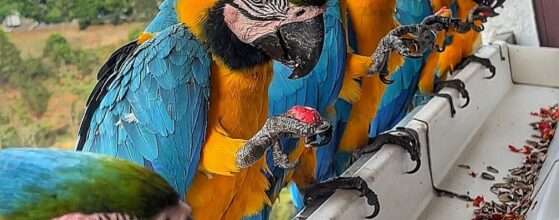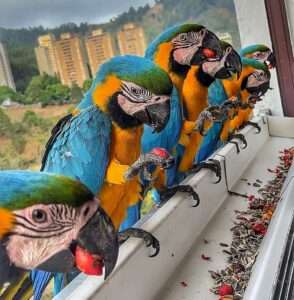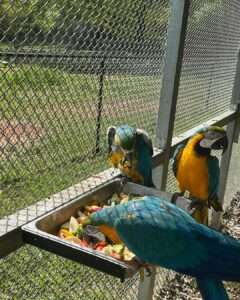
- by FPABS-Admin
- 0
- Posted on
Blue and yellow Macaw
Blue and yellow Macaw is a large members of the parrot family found throughout Central and South America. Their bright colors and loud vocalizations are important tools for communication but also make them easy targets for poachers.
PHYSICAL FEATURES AND CHARACTERISTICS:
Blue and yellow macaws is a large parrots weighing about 2 pounds. They have a 3 to 4-foot wingspan and a 1 to2 foot-long tail that helps guide them as they soar through the air. Their upper bodies is blue while their undersides is golden yellow. The long tail feathers is mainly blue and yellow. The chin and cheek area is pinkish white with thin lines of black feathers. Coloration on juveniles is dull and becomes brighter with age. These macaws have a hook beak which is grey black in color. Like other parrots blue and yellow macaws is their dark grey feet have two toes pointing forward and two toes pointing backward, each with a black claw.
LIFESTYLE AND REPRODUCTION:
Blue and yellow macaws like many other parrots is monogamous for life. Bond pairs fly close to one another within the flock. They reach sexual maturity around 3 to 4 years of age and breed seasonally base on their location. Pairs will nest in tree hollows or cavities that are very high up in trees. A clutch usually contains 2 to 3 eggs and parents incubate the eggs for 24 to 38 days. Young are independent around three months after hatching, but before then both parents are involve in rearing the hatchling which are born without feathers and are extremely vulnerable to predation.
RANGE:
Blue and yellow macaws is common in South America from Venezuela to Brazil, Bolivia, Colombia and Paraguay. They is restrict to Panama in Central America. There some reports of wild macaws living in Mexico and Florida; however, these are likely colonies start by escape pets.
DIET:
Blue and yellow macaws’ wild diet is a mix of seeds, nuts, and fruit. Their powerful beaks allow them to crack open hard-shelled nuts that other animals are unable to get into. They are messy eaters, dropping a lot of food from their mouths and enabling other animals to get in on the feast. At the Zoo they fed a diet of commercially prepare parrot chow fruit, vegetables seeds and nuts.
CONSERVATION:
Current population numbers is unknown but the population appears to be declining due to habitat loss, which results in a decrease of nesting sites. Historical capture of wild macaws for the international pet trade has also led to population declines. Some macaw species have gone extinct in the wild due to capture. Fortunately these parrots adaptive and have learn to live in urban environments
 making the loss of forest habitat less strongly felt than with some other rainforest species.
making the loss of forest habitat less strongly felt than with some other rainforest species.
